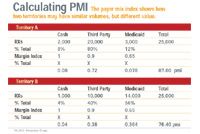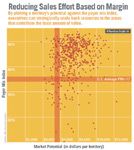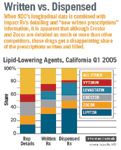No Margin for Error
Pharmaceutical Executive
When rebate strategies are coupled with sales force and DTC spending, it results in "margin-negative" business-that is, sales that bring in less than the marginal cost of selling, promoting, and manufacturing the drug.
Since the mid 1990's, every division vice president of a US pharma company has watched as each of the major parts of the organization—brand marketing, sales force, and managed care—has expanded and competed for resources. Growth in the spending of each of these areas now exceeds revenue growth. Industry's spending on all parts of its promotional arsenal—professional detailing, direct-to-consumer (DTC) advertising, and managed care discounting—has increased so significantly that it now finds itself stumbling under the weight of these investments. It's time to cut back. But how?
There are quick, obvious ways to reduce the cost of selling. Some companies, like Wyeth, will cut sales forces across the board. Others (think of TAP and its Prevacid brand) will slash DTC advertising or "just say no" to the trend in managed care rebates. These solutions may reduce costs, but they make no distinction between promotional investments that produce a high return and those that don't. Perhaps the worst solution of all: Some firms reduce sales territories through attrition, leaving opportunity-rich field positions unfilled while racking up costs for less productive positions.
Pharma has known for a while that each physician detail is not created equal. A physician may be in the top decile, but he won't generate much in the way of sales if your brand has a third-tier co-pay and patients won't pay it—or if more than half his patients are affiliated with state health programs or insurers that get deep discounts. Two providers can look identical in terms of their script-writing profiles, but one may be worth two or three times as much to the company.

Calculating PMI
That's not a new idea. Large pharma now recognizes that the one-size-fits-all sales force model has outlived its usefulness. But three things have changed recently to make that model even more obsolete.
- The Medicare drug benefit's multi-region structure is putting a new focus on geography, and new pressure on understanding customer profitability.
- Companies now have access to data, from both internal and third-party sources, that let them look far more closely at drug prescribing and purchasing. One key advantage: It is now possible to estimate average margin on a territory-by-territory basis.
- Because of Medicare and the increased aggressiveness of managed care organizations, access is emerging as a key issue in planning pharma sales strategies.
These trends point to an approach that makes it possible to cut marketing and sales costs rationally. Instead of slashing across the board, companies should take a targeted geographic approach to reducing the type and depth of sales force and promotional expense. In particular, two emerging models provide a roadmap to do this effectively. The first focuses on margins, and helps companies cut spending in territories where net sales margins are lowest. The second is an opportunity-based approach in which pharma organizations reduce sales and promotion expenses in specific geographies where managed care has neutralized the impact of detailing.

Reducing Sales Effort Based on Margin
These business-planning approaches consider sales force, DTC, and managed care rebates as levers that can be pulled in an integrated way to drive company profits. However, they do not yet exist throughout the industry. Instead, they are the necessary future for companies that want to reallocate promotional spending in a way that focuses on value—not volume—and offsets the growth of other sources of controllable spending.
Negative Thinking
You can't underestimate how important it is to control promotional spending when you consider that pharma has deployed between 90,000 and 100,000 sales reps and increased its spend on DTC to over $4 billion since 1997.
But what has really pushed these expenses past the tipping point is pharma's spending on managed care rebates and contracts. Over the last 10 years, the dollars pharma has rebated back to MCOs, PBMs, and national insurers has grown at two to three times the rate of companies' revenues, depending on the product portfolios involved. When those rebates are combined with Medicaid's "best price," consumer price index (CPI) adjustments, and state supplemental discounts, rebates for many manufacturers today represent a cash outflow that is now greater than all their direct-selling expenses combined, and may represent about 20 percent of gross sales.

California: MCO Shakedown
Of course, many companies, particularly in crowded therapeutic markets, feel it's worth it. They often justify payer bids based on a belief in a commensurate "spillover"—in other words, that providers apply their script-writing behavior under deeply discounted contracts to prescriptions not covered by that given contract. Executives tend to overuse the spillover argument, so when rebate strategies are coupled with sales force and DTC, it results in what's euphemistically called "margin-negative" business—sales that bring in less than the marginal cost of selling, promoting, and manufacturing the drug.
For many years, negative-margin deals were limited to federal programs, such as the VA, and a few aggressive state Medicaid programs, such as MediCal and MassHealth. However, the growth of supplemental rebates for state programs, the increasing power of MCOs, as shown by WellPoint, and the expectation by Medicare Part D providers that the exemption from best price will translate into deeper discounts may mean that as much as 50 percent of all prescriptions in some concentrated markets will be margin negative.

Written vs. Dispensed
The Payer Mix Index
The key to managing promotion in the new environment is to look closely at margins and access at the territory level and evaluate how much you're likely to make from selling the drugs, and identifying areas where you are unlikely to succeed.
Let's look first at margins. The easiest method to better align companies promotional resources against profit opportunities is creating a payer mix index (PMI) at the territory level.
To create a PMI, you break down your sales in a given territory by payer: the patient, third-party MCO, or Medicaid (and perhaps, down the road, Medicare). Then, determine the margins you make on each revenue source. MCO discounts and supplemental payments can be differentiated on a state-by-state basis, while the average commercial rebate in a state can be used as a close proxy to the actual rebates paid to each account. Some exceptions, where commercial rebates are outside the norm, should also be incorporated into the PMI. Finally, calculate an average margin for each territory, weighted by payer type. "Calculating PMI,", gives an example of how the process works: The two territories have similar sales volumes but very different mixes of payers and margins.

Same Share of Detailing, Different Results
The PMI provides a way of looking past sales volume to value. "Reducing Sales Effort Based on Margin" gives an example. Here, territory-level PMI has been plotted against potential sales volume. Most territories are in the upper-right quadrant: They combine higher PMIs that fall above the US average with high volume. But about 15 percent fall in the upper-left quadrant (low volume, high PMI) and about 15 percent fall in the lower-right quadrant (high volume, low PMI). If you want to reduce the cost of promotion while maintaining sales, which territories would you eliminate? It's pretty obvious that low-PMI territories need to go first. They may be generating sales, but they are not generating profit.
That is, of course, opposite of what most companies would do today. Without territory-level data on profitability, they focus on volume. Most eliminate low-volume territories and continue to detail their least-profitable customers.
Without reconfiguring the entire sales force, executives can gain an understanding of what territories contribute the least profit at the margin. In applying this practice, companies should look at geographic clusters of low-margin territories and determine if they should consolidate two or three low-value territories into one or two. In addition, PMI should be combined with other volume, potential, or workload information to identify outlier territories that contribute significantly greater or significantly less profit than average.
Territory-level analysis is particularly useful in allocating resources for a sales force. But the same analysis can be used at the prescriber level as well. By incorporating a measure of margin into the physician-profiling exercise, companies can prioritize reach and frequency to those healthcare providers who create the most value to the company.

Guiding Physician Targeting
Through this strategy, industry will find that many top-decile physicians are worth substantially less in profit contribution than many of the targets in the next decile. Therefore, this approach can help companies plan for a more effective allocation of field resources. Aggregating these physicians to higher levels of geography—metropolitan statistical areas (MSA) or states—will also provide insight on opportunities to reallocate other promotional spending to the highest-margin markets.
Is the Opportunity There?
Companies can also take a more comprehensive approach to sales and marketing resource allocation by identifying where managed care rebates trump direct selling. Companies that have products that are currently in the crosshairs of managed care—proton-pump inhibitors, angiotensin-receptor blockers, statins, and antidepressants—will see the greatest return from exploring this opportunity-based approach.
Many companies already adjust territory quotas or performance targets to reflect access to a drug in that market. However, few differentiate selling strategy or sales effort where their products are at a significant competitive disadvantage or advantage.
This approach is based on a methodology that combines several data sources at a state or regional level, including longitudinal-patient and dispensed-prescription data sources like NDC or Verispan, and real-time competitive detailing and prescription information captured in the physician's office from ImpactRx.
By matching physicians in both data sets, companies can aggregate de-identified patients by physician to connect promotional detail efforts to what medication is dispensed by the pharmacy. It also enables companies to understand:
- What was the relative detailing effort of each competitor?
- What products did the physician write for patients as a result of that detailing effort?
- Of the written new-patient starts and switches, how many did the pharmacy actually dispense?
By combining these two data sources, and possibly adding their own information from rebate claims submissions from MCOs, companies can finally quantify the relative importance of formulary status and pull-through from detailing efforts. In so doing, they can now identify geographies where detailing efforts make the most impact—and the areas where that effort is neutralized by relative formulary position. It is in these markets that companies can drastically reduce selling effort without affecting sales.
Take a look at lipid-lowering agents. This therapeutic class is extremely crowded and noisy, with several Big Pharma companies backing extensive selling efforts and DTC promotion. Formulary access varies widely by product. Most MCOs place Lipitor (atorvastatin) and Zocor (simvastatin) on preferred status, while Crestor (rosuvastatin), Vytorin (ezetimibe/simvastatin), and Zetia (ezetimibe) are most frequently non-preferred brands on patients' formularies. This category also has one generic—lovastatin (Mevacor)—and will soon have two others, simvistatin and pravastatin. In some markets, notably California, payers require step therapy with generic lovastatin, while other insurers encourage the use of the generic through low or no co-pays.
Using longitudinal patient data for California, manufacturers see the obvious impact of Pacificare's and Aetna's preference for lovastatin, most notably on Crestor and Zocor. AstraZeneca and Merck clearly know that their market share is lower in California, and possibly in these two payer accounts. However, without understanding how altering their promotional effort will affect prescribing, neither company will risk changing their detailing effort from the national norm. (See "California: MCO Shakedown".)
However, when this longitudinal data is combined with ImpactRx's detailing and "new written prescriptions" information, companies are able to quantify the results of their detailing efforts. (See "Written vs. Dispensed.") Crestor and Zocor are detailed as much or more than other products in the category, but those drugs get a disappointing share of the prescriptions written and filled. The opportunity to affect share performance is simply not available because of physicians' preference for prescribing lovastatin in California.
A similar conclusion could be reached in southern New England where both formulary status and physicians' strong preference for Lipitor combine to neutralize the effect of the sales force. But in other states, such as Alabama and Tennessee, selling effort still trumps formulary status for this class. (See "Same Share of Detailing, Different Results.")
AstraZeneca and Merck can use these data to identify regional-targeting strategies that maintain their current share with a far lower level of resources. In the case of California, Merck and AstraZeneca could simply cut detail effort to physicians who prescribe a high share of lovastatin, and lose little in the way of scripts. (See "Guiding Physician Targeting.")
Margin- and opportunity-based approaches require an increased sophistication in planning and execution. Most companies will resist implementation because it requires them to tap into parts of their businesses they never understood, through data they mostly have never used. There are other challenges. Limitations in available data mean the opportunity-based approach now works best at the state or MSA level. (But better information is set to become available from CMS under Medicare Part D, making this approach more practical on a lower level of geography.) In addition, these approaches require companies to adjust many core business processes, such as physician targeting, which they've institutionalized around volume, and which don't incorporate measures of profitability in reps' compensation program. Assuredly, there will be pushback from both sales management and operations before these value-based approaches can be adopted.
Perhaps the greatest challenge will be getting the three silos—brand management, sales management, and managed-markets organizations—to develop a common understanding of this model. However, companies that are successful can direct savings into higher-return activities, such as the health outcomes research that will be increasingly demanded from the largest and most circumspect payers.
Mason Tenaglia is managing director of The Amundsen Group. He can be reached at mtenaglia@amundsengroup.comPatrick Angelastro is senior vice president, strategic development at ImpactRx. He can be reached at pangelastro@impactrx.com

The Misinformation Maze: Navigating Public Health in the Digital Age
March 11th 2025Jennifer Butler, chief commercial officer of Pleio, discusses misinformation's threat to public health, where patients are turning for trustworthy health information, the industry's pivot to peer-to-patient strategies to educate patients, and more.
Navigating Distrust: Pharma in the Age of Social Media
February 18th 2025Ian Baer, Founder and CEO of Sooth, discusses how the growing distrust in social media will impact industry marketing strategies and the relationships between pharmaceutical companies and the patients they aim to serve. He also explains dark social, how to combat misinformation, closing the trust gap, and more.